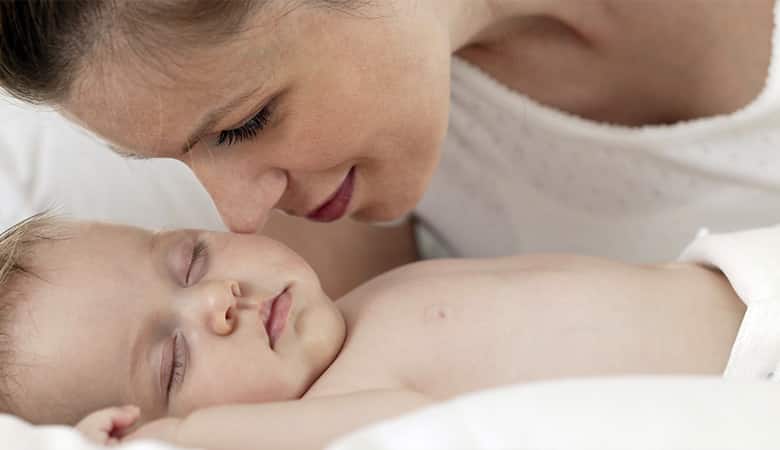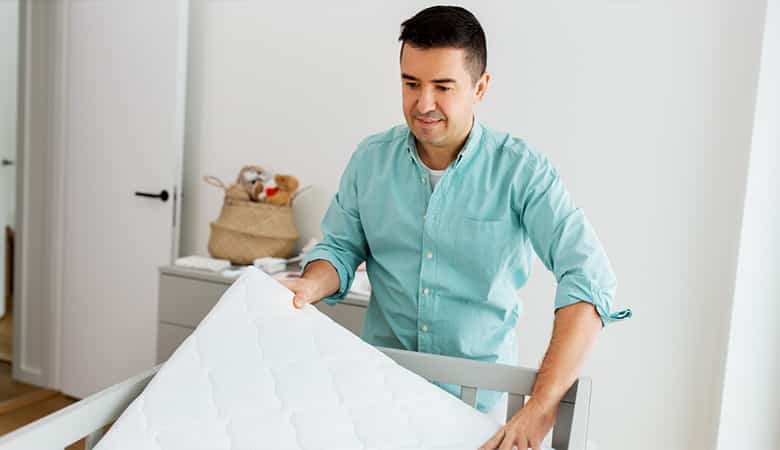Despite the sleepless nights and never-ending crying, babies are a joy to have in the house. They are a continuation of your legacy, and watching them grow is a delight.
As a parent, you want the best for your newborn and would go to any length to ensure that they grow up healthy and strong. Caring for a baby can be a daunting task, especially for first-time parents.
You are overwhelmed with all that is going on and will approach everything with caution. However, with the right information, your baby will grow up healthy, allowing you to put your mind at ease. One thing that you may struggle with is the type of mattress that your baby needs, especially the firmness.
Why should babies sleep on firm mattresses? Firm mattresses provide the necessary support needed for your infant’s skeleton to form properly. The bones have not fully solidified yet, and any misalignment may cause them to harden in the wrong position.
As a parent, you want the best for your child, and no one should fault you for that. But the healthy development of your newborn takes precedence. Your baby’s skeleton is still fragile, and a firm mattress provides adequate support to allow it to take its natural form.
As an adult, you have 206 bones compared to your infant’s 300, most of which are cartilage. As your baby grows, the bones fuse to form the conventional human skeleton that we all possess.
The reason why a firm mattress is vital is the lumbar support it offers. A firm mattress ensures that their spine is straight, allowing for the other bones to solidify correctly. It reduces the strain on this vital skeletal structure making your baby sleep comfortably.
A Firm Mattress Reduces The Chances of SIDS
Sudden Infant Death Syndrome (SIDS) refers to a situation where the death of an infant is still a mystery, even after thorough investigations. Studies around the subject have all concluded that having your baby sleep on a firm surface is a sure way of preventing SIDS.
The experts say that firm mattresses prevent your baby from suffocating during sleep should they decide to lie on their stomachs. Below are statements from both pediatricians and associated societies on the matter:
- Dr. Rachel Moon of the Children’s National Medical Center in Washington DC says ‘’ When it comes to babies’ sleep environment, soft is not safe, it’s actually dangerous.’’ She was speaking to a leading news agency following the publication of a study she co-wrote on Infant death Mortality among African American mothers.
- In 2016, the American Academy of Paediatrics added using a firm sleeping surface for your baby in their updated list of recommendations to reduce the risk of sleep-related deaths in infants.
- In her 2011 book, 14 Ways to Protect Your Baby from SIDS, Dr. Fern R. Hauck recommends firm sleeping surfaces as a sure way of preventing Sudden Infant Death Syndrome. Dr. Hauck is a SIDS researcher from the University of Virginia.
- The CDC also recommends a firm, flat sleep surface for babies as a way of promoting better child development and preventing SIDS.
- Other organizations that are in favor of firm mattresses include SafeKids.org, Healthy Families BC, The Canadian Pediatric Society, and many more.
What Other Benefits are There From my Baby Sleeping on a Firm Mattress?

Apart from the promotion of proper skeletal formation and reducing the risk of SIDS, there are many more benefits of using a firm mattress for their crib. Below are more of them:
Sleeping temperature
Firm mattresses are great for sleep temperature. They ensure that there are no air pockets above or surrounding your baby. As your baby is flat on the bed, air circulates freely, and the little guy is kept cool and comfy.
They prevent injuries to your little one
A firm mattress fits snug with the crib, meaning there will be no gaps where your child’s limbs can get stuck. As they grow, infants tend to roll in their sleep. If there are spaces in the crib, especially the corners, your newborn’s foot or hand can get stuck in them causing injury. As the baby’s bones are still forming, the chances of a fracture are very high.
Firm mattresses also reduce the chances of pressure points, since the baby is evenly spread across the bed. A soft mattress will dip where the baby exerts the most weight leading to soreness and bruising.
Firm mattresses reduce the chances of suffocation
You will not find your baby in the same position, as the one you put them when they slept. As their motor function increases, your baby explores all corners of the bed.
In the eventuality that they decide to sleep on their stomach, a firm mattress will not cover the baby’s face and they will continue to breathe normally. Soft mattresses on the other hand tend to form around surfaces, thereby increasing the risk of suffocation.
How Firm Should my Baby’s Mattress be?

Experts in children’s health advise that the firmer the mattress the better for your baby. You should ignore all the other advice you are getting from your relatives and friends. There are plenty of resources that you can use to help you in identifying the right mattress for your child.
One way is to consult your pediatrician or look on government-approved websites such as the Centre for Disease Control and Prevention and the American Academy of Pediatrics.
What Else do I Need to be Aware of, Besides a Firm Mattress?
Beddings and Crib
Firm mattresses are only part of the equation in ensuring the safety of your baby. You also need to be wary of the type of beddings and cribs that you use. Since your infant is still developing, they are still unaware of what is going on and need your help.
When it comes to selecting beddings, look for those that do not frail or have fine fibers. Your child can inhale the fibers leading to breathing difficulty as a result of obstruction.
Beddings made from cotton and flannel come highly recommended by childcare experts. You should also ensure that they have fitted corners, as they will prevent your baby from moving unnecessarily.
The crib should have high side walls with minimal spacing between the panels. They allow for proper air circulation and prevent your baby from falling over should they decide to roll.
Sleeping position
In the early stages of growth, you should always place your baby on their back. It helps with spine formation and development. A firm mattress will provide the necessary support needed to align the spine in the right configuration.
Any distortion with spinal development at this stage will lead to future complications. Lying on their back also helps the baby with breathing. Their faces are free from any obstruction, allowing for optimal breathing.
Firm mattresses are beneficial to early childhood development, and the science is there to back it up. You may think that your baby is uncomfortable, but in all honesty, babies can sleep anywhere.
Whether it is a pillow or your lap, once sleep comes calling, your baby will doze off. It is up to you as a parent to ensure that they are in a safe sleeping environment.
